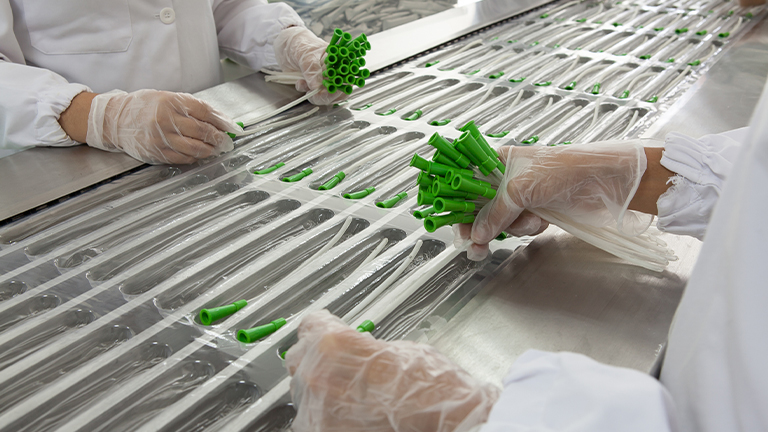Safety and efficacy once took precedence, but sustainability plays a growing role
For most of the 20 years that Carol Stillman has helped companies design medical devices, sustainability has always come second to other concerns. “There was a perception that it just wasn’t something that made sense for medical device companies to do, because the safety and efficacy was so important,” says Stillman, a project and program manager at Battelle, the nonprofit science and technology consulting firm focused on contract research and development work. “Trying to take into account these environmental aspects was something that was a low priority by comparison.”
In recent years, though, Stillman says she’s noticed a shift. With climate change a part of our daily conversation, and as governments, industry, and consumers embrace the need to rein in their use of the earth’s limited natural resources, sustainability is now “much more on health care companies’ radars.”

“It’s actually changed from a feeling like I’m really pushing this idea, to ‘it’s being asked for’,” she says. “There’s a pull for it.”
Unfortunately, the pull for more sustainability in medical device design has not come fast enough and the health care industry remains a significant driver of carbon emissions, plastic use, and waste in landfills around the globe. For years, hospitals didn’t pay much attention to the environmental hazards of the medical supplies they purchased, and consequently, device makers didn’t either.
“Even as sustainable business practices have gained momentum in other sectors, with more than half of Fortune 500 companies launching sustainability initiatives, the medical device industry has mostly sat on the sidelines, gauging sustainability as an unaffordable frill,” wrote Seth GaleWyrick back in 2014 in a blog published by the product engineering firm Bresslergroup.
Today, a quick search of the Federal Green Procurement Compilation, a comprehensive green purchasing guide used by federal contracting personnel and program managers, reveals that there are plenty of biomedical equipment categories devoid of sustainable choices, including items like PVC -free dialysis equipment and phthalate-free blood bags. What’s noted too often: “no federal source identified.”
According to the Health Care Plastics Recycling Council, health care facilities in the United States generate approximately 14,000 tons of waste per day, most of which is being disposed of in landfills or by incineration. About 5 million tons of health care waste ends up in landfills each year, including solid waste, regulated medical waste, hazardous waste, pharmaceutical waste, construction, and demolition debris. Globally, an estimated 2,000–3,000 tons of high-quality, nonhazardous, medical plastic enters municipal waste streams every day and only 14%–18% of that plastic waste is recycled, according to the World Economic Forum. Much of the plastic used in IV bags, catheters, perfusion and oxygen tubing, syringe casing, irrigation bottles, nutrition pockets, disposable gloves, and respiratory masks—a minute sampling of the thousands of medical supplies and devices used daily in any hospital—is made with PVC and phthalates identified as reproductive and developmental toxicants, not only for humans but for many other organisms, like fish. In fact, the EU (Medical Device Regulation 2017/745) has mandated that all phthalates considered carcinogenic, mutagenic, and toxic to reproduction or identified as endocrine-disrupting chemicals be used “only when prudent and justified, and when the benefits clearly outweigh the risks.”
Such concerns grow more worrisome with each passing year as medical devices and diagnostics become more sophisticated. Increasingly, devices incorporate electronics and mixed materials, making them even more difficult to dispose of safely. When a pregnancy test is thrown into the trash after five minutes of use, it can contribute not only to plastic waste but to e-waste that will linger in landfills for decades.
Given the fact that there is so much lost ground to make up for, many companies are rethinking the entire product lifecycle—how devices are designed, manufactured, distributed, and disposed of. They are reconceptualizing everything from materials to packaging to manufacturing processes. Although not every product can become perfectly sustainable, at least every product can become a little more sustainable. “You can make good decisions throughout the design process to make it as green as possible,” says Stillman.
Of course, part of the challenge is that medical devices must meet strict regulatory standards that don’t always take sustainability into account. As well, changes can sometimes have unimagined consequences.
“Even seemingly simple changes can introduce unexpected issues with device performance, safety or usability,” wrote a Battelle insider in May 2021. “For example, switching from a petroleum-based to a bio-based plastic housing may reduce overall greenhouse emissions for the device. However, if the new material has different physical properties (e.g., tensile strength, durability, aging), it could have an adverse effect on device performance or safety.”
Stillman, a mechanical engineer who specializes in BME and environmentally-sustainable design, has some basic advice to help engineers navigate what can sometimes be a rocky road to green design.
1) Start early in the process
According to Stillman, engineers and product designers should be considering how they can engineer for sustainability as soon as they conceive of an idea because, “that’s where you have the most opportunity to make significant changes in terms of what your opportunities are going to be throughout the rest of the project.”
Can materials be swapped for options that are more biodegradable, recyclable, and reusable? Can fewer materials be used for easier recycling? Can a device be made smaller or lighter to reduce the number of materials as well as the carbon emitted for distribution? Are there manufacturing options that will reduce energy and water use? Can packaging be minimized? Can a device be made reusable instead of single use? Could it be returned to the manufacturer for reprocessing? These are all questions manufacturers should be asking, keeping the end goal of use in mind, and staying open to out-of-the-box thinking.
2) Engage a multidisciplinary team
Input should come from everyone on the team, says Stillman. “Having the materials engineers working directly with the mechanical and electrical folks, also having a human centric design team that can go out and do that user research and really understand what people are trying to get at.”
Even if a product is already in the marketplace, it’s not too late for changes. “We can still make improvements,” she says. There is still opportunity to reconsider recycling options, institute takeback programs, or develop easier modes of disassembly.
3) Be clear on the tradeoffs
Safety and efficacy can never be compromised but other areas can be. Designers can compromise, for example, on time to market or cost per unit, says Stillman. Her job, she says, is to help clients decide where and which sustainability goals take priority, whether it be eliminating carbon emissions in transportation or reducing the waste stream. “Ideally, you want to address all of those different things, but we give them the opportunity to say what they are really trying to target the most,” she adds.
4) In the iterative process, consult the stakeholders and the end users
Consumers and stakeholders need to be involved. Consultation, Stillman says, should happen “throughout the process, not just upfront, not just one time, but as you’re iterating.”
5) Take time to assess and review
When a company comes up with a sustainable design, it should take time to formally assess its accomplishment. “It’s having that understanding of ‘this is what we were able to do’ and have that as a best practice for next time,” she says.
Sustainable device design has been an afterthought for far too long. Finally, says Stillman, it is being recognized as “one aspect of the triple bottom line—people, profit, and planet.”



